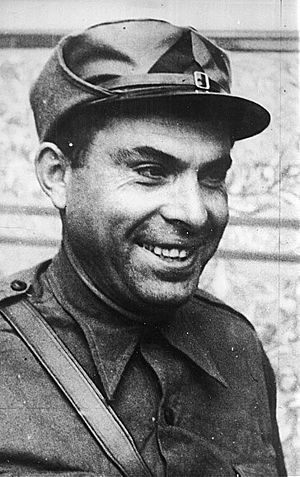Buenaventura Durruti facts for kids
Quick facts for kids
Buenaventura Durruti
|
|
|---|---|

Durruti in 1936
|
|
| Birth name | José Buenaventura Durruti Dumange |
| Born | 14 July 1896 León, Spain |
| Died | 20 November 1936 (aged 40) Madrid, Spain |
| Buried | |
| Allegiance | |
| Service | |
| Years of service | 1920–1936 |
| Commands held | Durruti Column |
| Battles/wars | Spanish Civil War |
| Spouse(s) | Émilienne Morin |
| Children | Colette Durruti |
| Signature | |
José Buenaventura Durruti Dumange (born July 14, 1896 – died November 20, 1936) was a Spanish anarcho-syndicalist activist. He was a key figure in the CNT and the FAI. These groups were important during the time leading up to and during the Spanish Civil War (1936-1939). Durruti played a major role in the Spanish Revolution of 1936. He is remembered as a hero by many in the anarchist movement.
Contents
Early Years and Activism
José Buenaventura Durruti was born in León, Spain. He was the second of eight children. His parents were Anastasia Dumange and Santiago Durruti. He started school at age five.
At 14, Durruti left school to become a mechanic. He worked in a railway yard in León. At 18, he joined the Unión General de Trabajadores (UGT), a socialist workers' union. In August 1917, he took part in a large strike. The government used the army to stop the strike. Many workers were hurt or put in jail. Durruti escaped to France. There, he met other anarchists who had also left Spain.
From 1917 to 1920, Durruti worked as a mechanic in Paris. He then returned to Spain. In San Sebastián, he joined local anarchists. They formed a group called Los Justicieros ("The Avengers"). Later, in Barcelona, he helped create Los Solidarios ("The Solidarity"). This was another well-known group of anarchists. These groups aimed to bring about social change.
After 1923, Durruti and his friends left Spain for a time. They traveled to places like Cuba. They later returned to Spain and Barcelona. Durruti became a very important leader in the Federación Anarquista Ibérica (FAI) and the Confederación Nacional del Trabajo (CNT). These were two of the biggest anarchist groups in Spain. His influence caused some changes within the CNT.
Role in the Civil War
Durruti worked closely with his friends in the FAI and CNT. He helped organize armed resistance against the military uprising that started the Spanish Civil War. This effort was very important in stopping General Goded from taking control of Barcelona. During a battle in Barcelona, Durruti's close friend, Ascaso, was killed.
Less than a week later, on July 24, 1936, Durruti led over 3,000 armed anarchists. This group became known as the Durruti Column. They marched from Barcelona towards Zaragoza. After a fight in Caspe, they paused their advance. Durruti famously said, "We renounce everything except victory." This showed his strong belief that the social revolution must continue alongside the war effort.
Durruti's Death
In November 1936, Durruti and his militia went to Madrid. They were there to help defend the city. On November 19, he was shot while leading a counterattack. This happened in the Casa de Campo area during the Battle of Madrid.
There are different ideas about how Durruti died. Some say he was killed by a sniper from the enemy side. Others believe a companion's gun went off by accident. At the time, for morale reasons, it was said he was hit by an enemy sniper.
Durruti died on November 20, 1936, at age 40. He passed away in a temporary hospital set up in the Ritz Hotel. He was buried in Barcelona's Montjuïc Cemetery. His funeral was a very large event. Over half a million people filled the streets to honor him. It was one of the last big public displays of anarchist strength during the Spanish Civil War.
Personal Life and Family
On July 14, 1927, Durruti met Émilienne Morin in Paris. She was a French anarcho-syndicalist and writer. They became life partners. When Durruti had to leave France, Morin went with him to Belgium. She worked to support them both.
In 1931, the couple moved to Spain. Their daughter, Colette Durruti, was born in Barcelona on December 4, 1931. Because Durruti was often away, Morin raised Colette mostly by herself. She had help from an anarchist friend, Teresa Margaleff. In 1936, Morin managed the press office for the Durruti Column. She also wrote many articles for French anarchist newspapers about the situation in Spain. After Durruti's death, she returned to France. She stayed involved in anarchist politics and helped raise money for Spanish refugees.
Durruti's Legacy
Durruti's death was kept secret for a short time to keep up morale. His body was brought across the country to Barcelona for his funeral. The huge number of people at his funeral showed how much he meant to the anarchist movement.
Historian Hugh Thomas noted that Durruti's death marked a turning point for Spanish anarchism. An anarchist poet said that Durruti's spirit would inspire "a legion of Durrutis" to follow him.
In 1937, a group called the Friends of Durruti Group was formed. They wanted to keep the original anarchist ideas of the revolution alive. They chose Durruti's name because he was a symbol of revolutionary commitment. The group had a newspaper and tried to spread their ideas among the CNT members.
Durruti's name has also appeared in popular culture. In 1966, a student group created a comic strip. One part was called The Return of the Durutti Column. This later inspired the name of an English post-punk band, The Durutti Column. More recently, an American anarchist used Durruti's last name as part of his alias.
Gallery
-
Durruti's grave at Montjuïc Cemetery, Barcelona
See also
 In Spanish: Buenaventura Durruti para niños
In Spanish: Buenaventura Durruti para niños
- Anarchism in Spain
- Anarchist Catalonia






